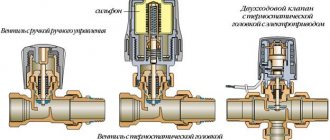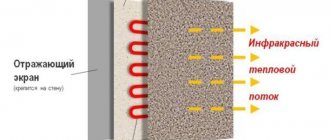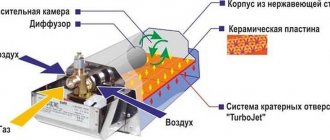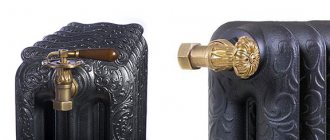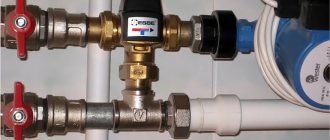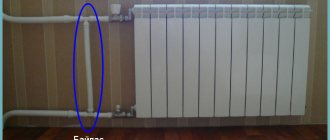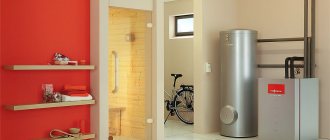What is it and what is it for?
A three-way thermostatic valve is a mixer designed to change the temperature of the coolant in the heating system.
Purpose and scope of the device
Even if we take into account all the heat losses and arrange the heating circuit in full accordance with the thermal calculation data, it will not be possible to exclude a malfunction in the heat balance as a result of the influence of external factors (temperature changes, wind loads, etc.).
In order to respond to these processes in a timely manner, maintaining a comfortable temperature in the room for a long time, shut-off and control valves - three-way thermostatic valves - are installed in the main line.
They are used both in conventional radiator heating circuits and in underfloor heating systems, where they provide:
- Redirection (distribution) of coolant flows.
- Mixing coolant flows with different temperatures to obtain a given temperature level.
- Protection of the floor covering from overheating (in underfloor heating systems).
For the same purpose, three-way thermal valves are often used in hot water supply systems, where they perform the function of a familiar mixer.
Technical characteristics of three-way valves
The main technical characteristics of three-way thermomixing valves are:
- Throughput: consumption of cubic meters of water per hour at nominal temperatures (20°C) and pressure.
- Inner diameter of pipes.
The parameters of the throughput and internal sections of all 3 pipes of three-way valves are most often the same.
- Maximum operating pressure.
- Dynamic range of regulation (the ratio of the throughput of a thermal valve under conditions of a fully open shutter to the same indicator with a half-closed shutter).
On a note! The dynamic range of control of three-way thermostatic valves, such as 50:1 or 30:1, belongs to the class of average. The best control properties are shown by devices with a dynamic control range of 100:1.
Sizes and nominal operating pressure values of three-way thermostatic valves are regulated by GOST 28338-89 and 26349-84, respectively.
What materials are three-way thermal valves made of?
A variety of metals and alloys are used to produce three-way thermostatic valves. When it comes to industrial facilities, the following are most often used:
Cast iron. It has anti-corrosion properties and fairly high strength. However, if production and operation technologies are violated, cast iron products can be quite fragile.
Black carbon steel. The material is durable, cheap, but susceptible to corrosion. To smooth out the last drawback, three-way valves are nickel-plated and chrome-plated.
Stainless (alloy) steel. The parameters are higher due to the addition of an alloy of nickel and chromium. High strength, resistance to oxidation and corrosion provide products with a long service life. However, such thermal valves are significantly more expensive.
For heating systems of private houses, brass three-way valves are most often used. Their temperature regime is limited to 200 °C, but within the allowed temperature range, brass devices can work for quite a long time. No less popular are polymer products used in the corresponding heating or plumbing circuits.
More expensive are three-way valves made of bronze, which are not inferior to their brass counterparts in strength. Bronze products are usually installed in copper heating circuits.
Important! Sometimes on sale you can find shut-off valves made of silumin (a low-strength aluminum alloy with silicon). Outwardly, they are very similar to products made of stainless steel or brass, but at the same time they are several times cheaper and, unfortunately, last only as long as they are priced at.
The internal locking mechanism in household products may be made of ceramic (with the exception of three-way motorized thermal valves). Ceramic mechanisms are chemically inert and durable, but are extremely sensitive to the purity of the transported coolant. Its low quality is the reason for the rapid wear of ceramic elements.
Installation rules
To install the thermal mixing valve in the position specified by the circuit, it is necessary to take into account a number of important nuances:
- Mounting method. Installation can be flanged or with internal/external thread. During fastening, conditions must be created to ensure a tight connection - using special gaskets, materials and mixtures.
- Installation on the return line to pumping equipment.
Only in this case can the condition of an always open outlet pipe be met.
Design and principle of operation of a three-way valve
The design of a three-way thermal valve is similar to a tee. There are pipe sections (nozzles) on 3 sides:
- Two (direct and bypass, indicated in the photo below as A and B) are intended for incoming or outgoing flow in mixing or separation mode, respectively.
- One (common, AB in the photo) - for outgoing or incoming (also in the mode of mixing or separating the coolant).
Inside the case there are:
- The rod that ensures the movement of the bolt mechanism.
- Locking mechanism (shutter).
- 2 seat rings that secure the bolt (not present on all models).
Depending on the specific modification, the design of a three-way thermostatic valve can be supplemented with other elements necessary for its full operation.
The design of the valve mechanism involves dividing three-way valves into 2 main groups - saddle and rotary, slightly different in operating principle. In addition, there are mixing and separation (distribution) thermal valves.
Seat three-way valves are equipped with a rotating stem with a ball, plate or cylindrical valve attached to it. The forward movements of the rod activate the bolt mechanism. Its functions:
- In the mixing mode, being in the uppermost position, it blocks the flow of liquid from pipe A, while simultaneously opening pipe B. Being in the lowest position, it blocks the flow of coolant from pipe B, opening pipe A.
- In the separation mode, the uppermost position of the valve leads to the closure of pipe B and the simultaneous opening of pipe A. The lowest position, on the contrary, closes pipe A and opens pipe B.
Three-way rotary valves are equipped with a 90° radial rotation stem:
- In mixing mode, turning the rod to the left closes port B and opens the flow of coolant from port A. Turning the rod to the right closes port A and opens pipe B.
- In flow separation mode, the leftmost position redirects the media flow in the direction of port A, and the far right position redirects the media flow in the direction of port B.
On a note! The common pipe AB is not blocked in any of the options, therefore it is characterized by a constant hydraulic mode.
Device, purpose, principle of operation
In simplified terms, a three-way valve for heating is a structure that combines two water taps in one housing. Depending on its purpose, the device mixes, separates or redirects coolant flows. It consists of the following main elements:
- Cases.
- Curtain or spherical element.
- Fastening coupling.
The distribution mechanism can be either manual using a metal ball or automatic using a rod operated by an electric drive based on a signal from a thermostat.
Note! When installing a heating system for a private home, not only a three-way boiler valve is used, but also its two-way analogue. Its main difference is that the rod element does not block the flow of coolant with unchanged hydraulic characteristics.
Advantages and disadvantages of thermostatic three-way valves
The undoubted advantages of using three-way thermostatic valves:
- Ease of influence on the temperature of the working environment.
- Practicality and energy efficiency of the heating system.
- Easy installation and maintenance.
- Long service life (depending on the material from which it is made).
Among the disadvantages, I would note the relatively high cost and the need for a filter in the heating circuit to ensure a high degree of cleanliness of the coolant.
Types of three-way valves and features of their operation
First of all, three-way thermal valves are classified according to their purpose into separation and mixing:
- The mixing valve has 2 directions to supply coolant of different temperatures (hot and cold), and 1 direction removes the already mixed liquid flow. Setting the required temperature parameters is carried out by adjusting the temperature and proportions of the supplied flows.
- The thermal distribution valve has 1 pipe supplying coolant, and 2 others divide it among themselves and distribute it in different directions.
For your information! Under certain conditions, the three-way mixing valve can operate in distribution mode.
According to the control method, three-way thermal valves are autonomous, manual, thermostatic and electric. The last two, as a rule, work automatically.
Simple stand-alone models are equipped with a thermostatic element installed inside the housing with the outlet coolant temperature already set at the factory. This value remains constant throughout the entire service life.
| Self-contained three-way mixing valve | |
| pros | Minuses |
| Low price | The need to select a valve for the return temperature of the heat generator |
| Coolant temperature control | The factory-set temperature setting cannot be changed. |
For manual control, the rod is equipped with a valve or rotary knob and a control panel with marks, according to which the thermal regime is regulated.
| Manual 3-way mixing valve | |
| pros | Minuses |
| Relatively low price | The need for constant human control, as a consequence, the protracted nature of the response to changes in environmental conditions |
| Coolant temperature control | |
| Possibility of changing temperature conditions during operation | Uneven heating of the heating circuit |
A three-way thermostatic valve with a thermostat is equipped with a thermostat filled with a liquid or gaseous medium that responds to the slightest fluctuations in coolant temperature.
As soon as the coolant heats up to the set temperature, due to the expansion of the reagent, the piston thermal valve system is automatically activated and the pipe with hot flows is closed.
Three-way valves with thermostat can be mechanical or electronic. The advantage of mechanical models is their absolute autonomy. Electronic ones require connection to a power supply or are powered by batteries.
However, this drawback is mitigated by the complete automation of the process, ease of setup and expanded functionality - automatic change of temperature according to the time of day, day of the week, etc.
| Three-way mixing valve with thermostat | |
| pros | Minuses |
| Automatic control of coolant temperature | High price |
| Ability to change temperature conditions | Extremely precise settings are required; errors in the set parameters lead to a small error in the operation of the system |
| Uniform heating of the heating circuit | |
Three-way thermal valves with electric drive are controlled by an electronic control unit operating on a servo drive. If the temperature of the coolant goes beyond the set values, it is detected by a thermostat installed in the module, which signals this to the controller. It transmits a command to the drive, regulating the flow of cold or hot coolant in the system.
In this case, none of the pipes, as a rule, is completely blocked, but only the volume of supplied cooled and hot coolant is regulated.
| Electrically actuated three-way mixing valve | |
| pros | Minuses |
| Automatic control of coolant temperature | High price |
| Possibility of changing temperature conditions | Increased energy consumption |
| Precise temperature control of the coolant flow | Increased coolant consumption |
| Uniform heating of the heating circuit | |
Three-way valve for heating with thermostat: diagram and main functions
Despite the external similarity with a tee, the valve performs completely different functions. The unit, supplemented by a thermal head, is the main element of the shut-off valves.
Maintaining a comfortable temperature
To maintain a comfortable air temperature, you need to control the heating. This can be done in two ways. In any case, manipulations with coolant flows are necessary. Thermal mixing valves are recommended for installation in houses with heated floors
Qualitative change in the properties of radiators
To regulate the quality of the coolant, the heat generator must be switched to a lighter operating mode (cold flow is supplied to the batteries).
You should know this! In a private home, you can change the mode in the boiler equipment. In urban high-rise buildings, all that remains is to regulate the temperature in the radiator.
Using a mixer you can maintain a comfortable microclimate
Quantitative heat flow control
If it is impossible to change the temperature of the coolant in any way, you should regulate the amount of liquid using a three-way control valve. Fewer flows will pass through the pipeline, therefore, the air temperature in the room will decrease.
Such a device is a three-way valve with a thermostat. With its help, you can limit (increase) the amount of liquid that passes through the heating system. In other words, a smaller (larger) amount of coolant will pass through the batteries, and the temperature balance of the room will change accordingly.
You can install the regulator on the battery and the three-way unit separately, but to increase efficiency it is recommended to install a mixer with a thermostat.
Thread separation scheme
Service life of three-way valves
The most important factors affecting the service life of a three-way valve:
- The material from which it is made.
- Compliance with the operating conditions prescribed by the manufacturer - temperature conditions and coolant quality.
- Intensity of use.
- Installation quality.
On average, manufacturers provide a guarantee for their products ranging from 5 to 7 years, which means that a three-way valve can easily work 2 times longer. But the warranty for plastic models does not exceed 1 year.
The valves with a manual control system have always been recognized as the most reliable. Electronic and thermostatic sensors fail much faster than the valve itself and require repair or complete replacement.
Electrically adjustable models
A three-way valve with an electric drive allows you to control the flow of coolant in the heating system of a private home as efficiently as possible. Unlike its manual counterpart, when the user independently sets the immersion level of the control rod in the mixer, this option is equipped with a special electric motor - a servo drive. Compared to a standard motor, the shaft in it does not rotate around its axis, but rotates at a given angle at the command of the controller.
Today on the market of specialized devices you can find two types of 3-way valves with a drive:
- Fully equipped.
- Only with drive and sensor.
Models of the first type are equipped not only with an electric motor, but also with a temperature sensor and controller. The latter are equipped only with a motor and a heating sensor. They will require a separate purchase of a control module. The task of this block is to analyze the signal coming from the temperature sensor, process it and perform the appropriate action.
Electric valve Source armastock.ru
For example, when the heating level drops, the sensor sends a signal to heat up. Having received the information message, the controller sends a command to the drive to rotate the rod accordingly in order to open the valve to allow the hot flow to pass from the pipe into the system.
Note! The electric drive model allows you to quite accurately set the parameters for adjusting the heating system and link events to time or even to smart control. However, a conventional three-way thermostatic valve is more stable, does not require a power source for operation, is inexpensive and allows you to control the temperature according to a strictly specified value.
How to choose a three-way valve
The range of three-way thermal valves is extremely wide. How to choose a model so that it matches the technical characteristics of the heating system at home? Pay attention to the following parameters:
- The type of bolt mechanism is rotary or saddle. The latter ensures a tighter seal of the valve and more accurately regulates the pressure even under conditions of high temperatures and pressure changes.
- Control type. It can be autonomous, manual, thermostatic and electric. Electric servo-driven models are most suitable for water-heated floors.
- Scope of use. Hot water supply, heating - radiator or heated floor. For DHW - separating circuits, for heating circuits - mixing circuits.
- Valve material. Brass and copper fittings last much longer.
- The diameter of the pipes to which the thermal valve will be connected.
- Connection method: threaded or flanged. For cross-sections above 65 mm, flanged models are usually installed.
Next, you should rely on the data from the thermal and hydraulic calculations of the heating circuit and specifically the area where you plan to install the three-way valve:
- Pressure.
- Maximum coolant temperature at the valve installation location.
- Average water consumption (m³ per 1 hour).
This data must coincide with the markings on the valve itself or the information in the accompanying documentation for the product.
On a note! Do not confuse a three-way thermomixing valve with a similar tap. Despite the similar design and operating principle, the difference in the control system is significant. For complex heating systems, it is better to use a valve, but for small and extremely simple ones, a manually operated tap is quite suitable.
Popular Three Way Valve Manufacturers
Among the numerous manufacturers of three-way thermal valves, I would highlight the following five leaders. They specialize in the production of engineering plumbing, thermostatic equipment and are actively introducing the latest energy-efficient technologies:
- ESBE (Sweden).
- IMI-HEIMEIER (a holding company that includes 3 production complexes).
- Danfoss (Germany).
- HERZ (Austria).
- Valtec (Italy, Russia).
Valtec is a special project, the production of a variety of engineering plumbing adapted to Russian realities. A special plus is the reasonable price and long warranty period for the products.
How much do three way valves cost?
The cost of a device consists of many aspects - the material from which they are made, technical equipment, brand reputation. Whether it's worth overpaying for it is up to you to decide.
Connection diagrams for a three-way valve to a heating network
After all the analysis regarding the design of the valve and its operating principle, an understanding emerged of how it can be used in various heating systems. Most often it is used in three cases.
- In a heated floor system, the coolant temperature should be within +45°C. It is this mode that is supported by the device. This has already been discussed above, and it has been shown how it should work.
- To protect solid fuel boilers from the formation of condensation inside the firebox. This happens when relatively very cold return water enters the generator heat exchanger. This causes water droplets from condensed steam to form on the outer surfaces. This should not be allowed, because condensation shortens the life of the equipment.
- If there is a need to maintain different temperatures in different parts of the heating system.
The first option will not be considered, because it has already been described. As for the second case, we need to take the photo below as a basis for analysis.
Piping diagram for a solid fuel boiler with a three-way valve
The diagram shows a double circuit: one large one passes through the radiators, the second is a short one through the bypass (this is a vertical red line, the beginning of which is at the top to the radiators, the end rests at the bottom of the valve). Until the boiler warms up, the coolant moves along a short circuit. The temperature has risen to the required level, the valve closes the bypass and opens the return (lower blue line).
And the third position, which is based on the distribution of coolant among consumers, in them the required temperature is not always the same. For example, an indirect heating boiler requires water at a higher temperature, for radiators at a lower temperature, and for heated floors even less.
Attention! In such a scheme, there is no need to install control shut-off valves in front of the boiler.
The wiring diagram for installing a three-way valve should be approximately as shown in the photo below.
Coolant distribution among consumers
Rules for installing three-way valves
So that the consumer does not suffer from the question of how to correctly install a three-way thermomixing valve, the manufacturer supplies its products with carefully developed instructions and applies special markings to each product, which helps to accurately determine the direction of flow:
- The pipe marked with the letter “A”, the so-called “direct stroke”, is intended for connection to a pipe with a hot coolant.
- The pipe with the letter “B” (“bypass passage”) is connected to the pipe supplying chilled water.
- The pipe marked “AB” (stroke with constant hydraulic mode) is connected to the main transport line intended for transporting already mixed coolant.
Place of the three-way valve in the heating circuit
First, let's look at the general connection diagrams to the heating circuit. Simplified, they can be represented as follows:
As can be seen from the diagram, three-way thermal valves can be installed both on the heat branch coming directly from the boiler, and on the return line. However, this does not mean that absolutely any valve can be installed this way. The capabilities of this or that equipment are determined by the permissible thermal conditions specified by the manufacturer in the data sheet.
Below is a more complex diagram that allows you to fully automate the operation of the heating system:
The following rules must be observed during installation:
- The following must be installed in front of the valve: pressure gauge, filter, throttle diaphragm (washer).
- After the thermal valve, another pressure gauge is installed.
- In front of the valve, it is advisable to maintain a straight section of pipe equal to 5 of its nominal diameters; behind the thermal valve, the length of the straight section should be at least 10 of the nominal pipe diameters.
- In complex or excessively long heating lines, the problem of low pressure is solved by installing a circulation pump.
- In horizontal sections, the valve itself is placed in such a way that the electric drive, thermostatic insert or thermostat is located above it.
- Threaded connections are joined using flax fiber laid on the thread in 2-3 layers and sealant.
- During the tightening process, excessive forces on the mating elements should be avoided; stretching, compressing or bending them should not be allowed.
Place of a three-way valve in water supply systems
The installation diagram of a three-way valve presented below clearly illustrates the principle of its connection to a water heater and installation options in pressure and non-pressure water supply systems:
The nuances of installing a three-way valve in a heating system
In order to correctly install a three-way mixer, it is important to know some of the nuances on which the uninterrupted and efficient operation of the heating system will depend.
Each product comes with instructions; strict adherence to them is necessary to avoid troubles:
- Follow the instructions on the body to set the valve to the correct position.
The symbols on the body mean:
- A – straight forward.
- B – perpendicular or bypass stroke.
- AB – input and output are combined.
Marking on the mixer body
- It is important to determine the crane model. This determines where the coolant will come from to the tap;
- In a symmetrical (T-shaped) scheme, the liquid enters the holes from the end and exits after mixing through the center;
- in an asymmetrical (L-shaped) scheme, the warm flow enters through the end hole, and the cooled flow enters from below. After mixing, the coolant exits through the second end hole.
It is important! The drive or thermostat should not be located at the bottom.
After this, it is necessary to prepare the heating system. First, turn off the water, then check for sediment in the line, which can damage the mixer. For installation, you need to choose a convenient place with open access.
Mixer installation features
Connection diagram for distribution and mixing valve
